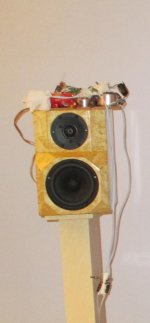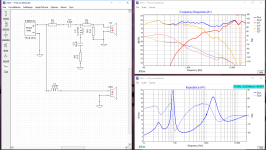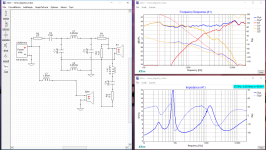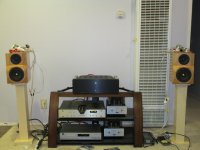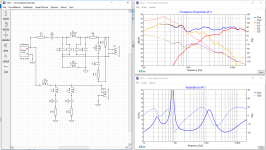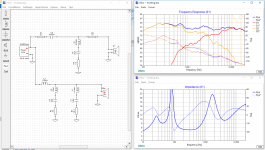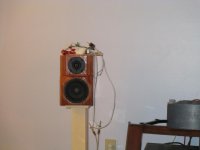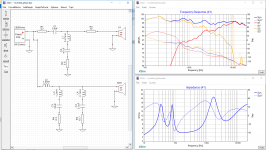I've have made two separate first xover versions to see there is any difference. One is fist order but the tweeter is inverted. The other is tweeter and and woofer are both in-phase using a all phase delay network. Both xover are very similar and the only difference is the series capacitor on the tweeter.
The drivers are SBA Satori TW29RN-B and Scanspeak 15W/4531G.
After listening both versions here are my impressions.
For the inverted version, there is a transparency due a much simpler signal path. The sound is a bit more immediate and the vocal seems a bit closer to the listener. On the time-aligned version, there is a slight veil on the very top end. I mean the signal has to travel through the delay network with all the inductor and capacitor component so it's reasonable to expect there is some loss in the signal rise time. So in term transparency, the advantage is the simpler inverted xover version.
Now in term of soundstage reproduction, the advantage is the time-alinged version. The time aligned has a more palpable and 3D presentation. There is a track where the bass is sort of bouncing left and right and even behind the listener. On the inverted over, the bass is mostly at the front and within the speaker boundary or just slightly to the left and right of the speakers. But on the time-aligned version I could hear the bass effect from the left to the right wall and even behind me. Another example, on Pink Floyd Wish you were here album, at the beginning of the second track Welcome to the machine, there is a sound affect that sounds like pressurized door opening from the right side of the soundstage, on the time-aligned version, the sound comes from right at the right wall, but on the inverted version, the sound is about halfway from the left speaker to the wall. Overall, the time-aligned has a more three dimensional soundstage at the expense of transparency. At almost every track, on the time aligned version, the sound just extends more to the left and right of the speakers, and there is a cohesion that not heard in the inverted xover version.
My observation is consistent with John Atkinson observation (although I don't remember the link) in which he said everything being equal, the time-aligned speakers have an edge over soundstage reproduction. That is what I heard.
So I guess what is the verdict? I am not sure there is a clear winner. Each has its own strength and weakness. But what if I could purchase the best capacitors for the delay network? I think the time-aligned version has a higher ceiling potential that is you can get more out of it with expensive caps, where is the inverted version is limited by the physics.
The drivers are SBA Satori TW29RN-B and Scanspeak 15W/4531G.
After listening both versions here are my impressions.
For the inverted version, there is a transparency due a much simpler signal path. The sound is a bit more immediate and the vocal seems a bit closer to the listener. On the time-aligned version, there is a slight veil on the very top end. I mean the signal has to travel through the delay network with all the inductor and capacitor component so it's reasonable to expect there is some loss in the signal rise time. So in term transparency, the advantage is the simpler inverted xover version.
Now in term of soundstage reproduction, the advantage is the time-alinged version. The time aligned has a more palpable and 3D presentation. There is a track where the bass is sort of bouncing left and right and even behind the listener. On the inverted over, the bass is mostly at the front and within the speaker boundary or just slightly to the left and right of the speakers. But on the time-aligned version I could hear the bass effect from the left to the right wall and even behind me. Another example, on Pink Floyd Wish you were here album, at the beginning of the second track Welcome to the machine, there is a sound affect that sounds like pressurized door opening from the right side of the soundstage, on the time-aligned version, the sound comes from right at the right wall, but on the inverted version, the sound is about halfway from the left speaker to the wall. Overall, the time-aligned has a more three dimensional soundstage at the expense of transparency. At almost every track, on the time aligned version, the sound just extends more to the left and right of the speakers, and there is a cohesion that not heard in the inverted xover version.
My observation is consistent with John Atkinson observation (although I don't remember the link) in which he said everything being equal, the time-aligned speakers have an edge over soundstage reproduction. That is what I heard.
So I guess what is the verdict? I am not sure there is a clear winner. Each has its own strength and weakness. But what if I could purchase the best capacitors for the delay network? I think the time-aligned version has a higher ceiling potential that is you can get more out of it with expensive caps, where is the inverted version is limited by the physics.
Attachments
everything being equal
Thats not the case in yours. The slightest amplitude variation >0.5dB is more audible than the phase. Also in analogue circuit you can create distortion. Additional influence.
An allpass can only delay lows further than it already is without. So its not actually a time correction. It can only allow with given baffle delay to have the XO frequencies of both drivers in-phase in steady state. The overall group-delay though only worsened.
So, youre comparing apples and pers here. I recommend you to focus on flat amplitude on- and off-axis, forget the phase. Maybe consider distortion vs filter-steepness.
Groupdelay (if u dont build crazy 4-5way passive 8th order frankenstein circuit) is rather a cherry on the cake, only being properly solved by FIR, nothing else.
cheers
Josh
Andy,
This is all fun and games, so no big deal, but doing blind testing with listeners who had no idea what was going on would be more convincing. I am afraid that your post reads like you had quite a bit of confirmation bias. You seem to explain what you expect, then prove it.
Also, assuming any of this was shown to be significant, testing to eliminate alternative explanations would further shore up your original argument.
Finally, putting your subjective impressions into perspective is something most reviewers miss. When a reviewer says something is better, it is important to put it into scale. How much better? Ground breaking? Could you really notice it blindfolded? Could most? Is it really better or just different? As a feature, how much would you pay to move that goalpost? $1 or $10,000 ?
Best,
E
This is all fun and games, so no big deal, but doing blind testing with listeners who had no idea what was going on would be more convincing. I am afraid that your post reads like you had quite a bit of confirmation bias. You seem to explain what you expect, then prove it.
Also, assuming any of this was shown to be significant, testing to eliminate alternative explanations would further shore up your original argument.
Finally, putting your subjective impressions into perspective is something most reviewers miss. When a reviewer says something is better, it is important to put it into scale. How much better? Ground breaking? Could you really notice it blindfolded? Could most? Is it really better or just different? As a feature, how much would you pay to move that goalpost? $1 or $10,000 ?
Best,
E
First of all, Josh is fully right. The individual )=filtered) LP and HP curves, plus the summed SPL curves a rather different.
In the steep vs shallow slopes thread dBMandrake in post 380 made some very interesting observations, which may be compared to yours.
Look here; Well I suppose the shallow vs. steep argument will just go on and on.
Eelco
In the steep vs shallow slopes thread dBMandrake in post 380 made some very interesting observations, which may be compared to yours.
Look here; Well I suppose the shallow vs. steep argument will just go on and on.
Eelco
I've have made two separate first xover versions to see there is any difference. One is fist order but the tweeter is inverted. The other is tweeter and and woofer are both in-phase using a all phase delay network.
Did you just model them, oder did you also measure the actual result of your builds? Also, I would suggest to also look at results in the time domain, not only in terms of frequency response. Comparing the time domain measurements (step response) with your subjective results might be interesting.
I appreciate everybody's response.
Although I agree that it's not apple to apple in the strictest sense, but in this case it's more small apple vs. large apple. They are very similar with just a delay network. I don't have any confirm bias. I actually like the inverted version a lot but the 3D and more cohesive soundstage of the "time aligned" version is consistent when I tried this similar xover with other speakers.
I understand what you said about the delay network and I have my own doubt as to whether it actually is a time correction since it does add its own phase signature and it seems like we could use a bit more science here, but nobody seems able to have any specific so my own vudoo approach is the only thing I have.
We can look at the time domain using step response but how do we correlate that to the actual listening results? I am not the only one who experienced that time-alinged speakers have a better 3D soundstage, but I agree that it's subjective and other people might have other priorities such as transparency, resolution, and clean sound.
Although I agree that it's not apple to apple in the strictest sense, but in this case it's more small apple vs. large apple. They are very similar with just a delay network. I don't have any confirm bias. I actually like the inverted version a lot but the 3D and more cohesive soundstage of the "time aligned" version is consistent when I tried this similar xover with other speakers.
I understand what you said about the delay network and I have my own doubt as to whether it actually is a time correction since it does add its own phase signature and it seems like we could use a bit more science here, but nobody seems able to have any specific so my own vudoo approach is the only thing I have.
We can look at the time domain using step response but how do we correlate that to the actual listening results? I am not the only one who experienced that time-alinged speakers have a better 3D soundstage, but I agree that it's subjective and other people might have other priorities such as transparency, resolution, and clean sound.
Did you just model them, oder did you also measure the actual result of your builds? Also, I would suggest to also look at results in the time domain, not only in terms of frequency response. Comparing the time domain measurements (step response) with your subjective results might be interesting.
The drivers responses are from actual measurements. I did measure in-room frequency response and it's pretty close to my simulation results.
First of all, Josh is fully right. The individual )=filtered) LP and HP curves, plus the summed SPL curves a rather different.
In the steep vs shallow slopes thread dBMandrake in post 380 made some very interesting observations, which may be compared to yours.
Look here; Well I suppose the shallow vs. steep argument will just go on and on.
Eelco
It's interesting that the inverted xover actually has a more "they are there" illusion so you would think it should be able to have a more enveloping soundstage but the time-aligned version just have a more cohesive presentation abeit with slight loss in the very top end and as I said it's probably because the tweeter signal has to travel through all that components. So it's not like I think the time-aligned version is better at everything. I can't seem to put a finger on it, I don't know what it is, I can't see it yet, but the soundstage of the time-aligned just more natural. What if I have money to purchase 4 x 40uf of Mundorf M-Cap supreme?
The drivers responses are from actual measurements. I did measure in-room frequency response and it's pretty close to my simulation results.
And what about the time domain results? Step response? (see my previous comment)
Most monitors aren't 6db crossed and time aligned (usually tweeter set back) for a clean triangle step response either.
And that is what your music was mixed on.
The room changes the sound a bunch too.
I like smily face eq on my music.
I think it's all about how we want it to sound.
And that is what your music was mixed on.
The room changes the sound a bunch too.
I like smily face eq on my music.
I think it's all about how we want it to sound.
You cannot simply say I didnt have confirmation bias, that is pretty much the definition of confirmation bias.
A way to alleviate this would be to number the crissovers 1 and 2 have someone else wire up the crossovers and not tell you which one is wired in. Then record your findings for each listening session. Repeat several times, you will at least need a voting set of 3 tests on each configuration so a minimum of 6 tests.
If you can pick out the differences blind and if you dont tell your helper which is which it would be almost double blind. Better if they don’t stay in the room or talk to you after each set up.
That would remove confirmation bias to some extent, the problem would then be there might be enough frequency response difference for you to spot which is which and then comfirmation bias could reapear.
Having said that I have done many sighted tests and just accepted the risk of confirmation bias.
A way to alleviate this would be to number the crissovers 1 and 2 have someone else wire up the crossovers and not tell you which one is wired in. Then record your findings for each listening session. Repeat several times, you will at least need a voting set of 3 tests on each configuration so a minimum of 6 tests.
If you can pick out the differences blind and if you dont tell your helper which is which it would be almost double blind. Better if they don’t stay in the room or talk to you after each set up.
That would remove confirmation bias to some extent, the problem would then be there might be enough frequency response difference for you to spot which is which and then comfirmation bias could reapear.
Having said that I have done many sighted tests and just accepted the risk of confirmation bias.
You cannot simply say I didnt have confirmation bias, that is pretty much the definition of confirmation bias.
A way to alleviate this would be to number the crissovers 1 and 2 have someone else wire up the crossovers and not tell you which one is wired in. Then record your findings for each listening session. Repeat several times, you will at least need a voting set of 3 tests on each configuration so a minimum of 6 tests.
If you can pick out the differences blind and if you dont tell your helper which is which it would be almost double blind. Better if they don’t stay in the room or talk to you after each set up.
That would remove confirmation bias to some extent, the problem would then be there might be enough frequency response difference for you to spot which is which and then comfirmation bias could reapear.
Having said that I have done many sighted tests and just accepted the risk of confirmation bias.
Yes, that would be an ideal unbiased test, but I guess I don't have someone at my disposal so it's sort of hard but even if I do, that person may not be an audiophile to know what to listen for. But as I said previously it's not an apple vs. orange, it's more like small apple vs. large apple.
So this is like inverted phase vs. time aligned #2. The woofer this time is Seas Nextel 5in. Same tweeter. To be honest may be I can bs my way through this post but this time I can't say the "time aligned" version is better. It's like comparing Ms. Upton in the morning vs. in the evening and not like vs. some other gal. Maybe the inverted phase is morning Upton and the time aligned is evening Upton.
Maybe the "time aligned" version has a more organic soundstage but maybe it's just me.
Maybe the "time aligned" version has a more organic soundstage but maybe it's just me.
Attachments
Last edited:
Anyway, just got my Illuminator 5.5in and got to try it out with the SBA dimple tweeter. Sounds really nice. The revelator is nice but it a bit lush and lacks a little bit of micro detail. The Seas Nextel has lots of micro details but maybe a little a bit too much of it so one has to be careful with xover. The Illuminator is like the best of two world - still does not have the micro details of the Nextel but it just has enough but at the same time very natural sounding and really good bass for its size.
The SBA dimple tweeter is a little bit subdue sounding vs. its Satori version. On the other hand, the Satori dimple tweeter could be a handful. It has a slight peak around 2K to 4K then after around 8K it perks up to around 2db. With mass strings playing, there is a brittleness on the treble that sometimes can be very distracting. I wished I had bought the AirCir.
The SBA dimple tweeter is a little bit subdue sounding vs. its Satori version. On the other hand, the Satori dimple tweeter could be a handful. It has a slight peak around 2K to 4K then after around 8K it perks up to around 2db. With mass strings playing, there is a brittleness on the treble that sometimes can be very distracting. I wished I had bought the AirCir.
Attachments
Hi Andy2, I think your impression of the sounds of both crossovers are normal and well expected. I believe that in both crossovers I will prefer the inverted versions...
But the critical point from your experiment is the mentioned subjective quality of the "time-aligned" version. I believe it is not the "time-aligned" character that you heard.
To test this, here is what you can do:
Build a normal NON-INVERTED tweeter crossover. Then create your "time-aligned" version using the delay network and compare.
But the critical point from your experiment is the mentioned subjective quality of the "time-aligned" version. I believe it is not the "time-aligned" character that you heard.
To test this, here is what you can do:
Build a normal NON-INVERTED tweeter crossover. Then create your "time-aligned" version using the delay network and compare.
Hi Andy2, I think your impression of the sounds of both crossovers are normal and well expected. I believe that in both crossovers I will prefer the inverted versions...
But the critical point from your experiment is the mentioned subjective quality of the "time-aligned" version. I believe it is not the "time-aligned" character that you heard.
To test this, here is what you can do:
Build a normal NON-INVERTED tweeter crossover. Then create your "time-aligned" version using the delay network and compare.
I am waiting for someone to created a proper "time aligned" version, but so far nobody able to come up with one. All critics and theories so far but no cigar. If someone has one, I'll try.
Some people will do their best to make sure that no driver is inverted in a speaker crossover.
My favorite movie quote is "We don't pay you to do your best, we pay you to do your job."
Andy, your speaker is NOT 1st order. Look closely at the roll-off slopes of both the woofer and tweeter. The woofer rolloff is 12 dB/octave, which makes it a second order. The tweeter rolloff is 1st order making it an asymmetrical crossover network. Not sure how your delay network work to make them "time aligned". In crossover design, you must consider the equivalent circuits of the drivers. They are part of your crossover and it is an unavoidable fact. Using a single crossover component in the woofer path usually results in a 2nd order rolloff.I've have made two separate first xover versions to see there is any difference. One is fist order but the tweeter is inverted. The other is tweeter and and woofer are both in-phase using a all phase delay network. Both xover are very similar and the only difference is the series capacitor on the tweeter.
The drivers are SBA Satori TW29RN-B and Scanspeak 15W/4531G.
After listening both versions here are my impressions.
For the inverted version, there is a transparency due a much simpler signal path. The sound is a bit more immediate and the vocal seems a bit closer to the listener. On the time-aligned version, there is a slight veil on the very top end. I mean the signal has to travel through the delay network with all the inductor and capacitor component so it's reasonable to expect there is some loss in the signal rise time. So in term transparency, the advantage is the simpler inverted xover version.
Now in term of soundstage reproduction, the advantage is the time-alinged version. The time aligned has a more palpable and 3D presentation. There is a track where the bass is sort of bouncing left and right and even behind the listener. On the inverted over, the bass is mostly at the front and within the speaker boundary or just slightly to the left and right of the speakers. But on the time-aligned version I could hear the bass effect from the left to the right wall and even behind me. Another example, on Pink Floyd Wish you were here album, at the beginning of the second track Welcome to the machine, there is a sound affect that sounds like pressurized door opening from the right side of the soundstage, on the time-aligned version, the sound comes from right at the right wall, but on the inverted version, the sound is about halfway from the left speaker to the wall. Overall, the time-aligned has a more three dimensional soundstage at the expense of transparency. At almost every track, on the time aligned version, the sound just extends more to the left and right of the speakers, and there is a cohesion that not heard in the inverted xover version.
My observation is consistent with John Atkinson observation (although I don't remember the link) in which he said everything being equal, the time-aligned speakers have an edge over soundstage reproduction. That is what I heard.
So I guess what is the verdict? I am not sure there is a clear winner. Each has its own strength and weakness. But what if I could purchase the best capacitors for the delay network? I think the time-aligned version has a higher ceiling potential that is you can get more out of it with expensive caps, where is the inverted version is limited by the physics.
With a 2-way system, you will need a RLC tanking network to tame the woofer break-up around 4.5 KHz. I can see that the woofer breakup bump caused a broadband drop in the upper midrange in the reverse polarity version. It can give a completely different impression of the system and has nothing to do with "time alignment".
Looking at the phase response curves of the 2 systems, the first one with the reversed driver connection actually has less less phase variation, but a much more rugged frequency response due to the woofer breakup. It may be partially due to its much higher crossover point (compared to the 2nd system).
I was in the same situation as you are 2 years ago. I came to this forum and received a lot of help from many members, particularly, wintermute, Zuhl, jReave, AllenB and System7 who were all very gentle to the new comer, me, and extremely helpful. See my thread about that experience.
The crossover for a modest DIY bookshelf speaker project
I prefer higher order crossover to compensate for driver imperfection. I got a system with excellent sound staging including depth.
Good luck with your adventure. It is NOT mysterious. It is solid science and physics.
Last edited:
- Status
- This old topic is closed. If you want to reopen this topic, contact a moderator using the "Report Post" button.
- Home
- Loudspeakers
- Multi-Way
- First order vs. First order time-aligned and a dilemma
